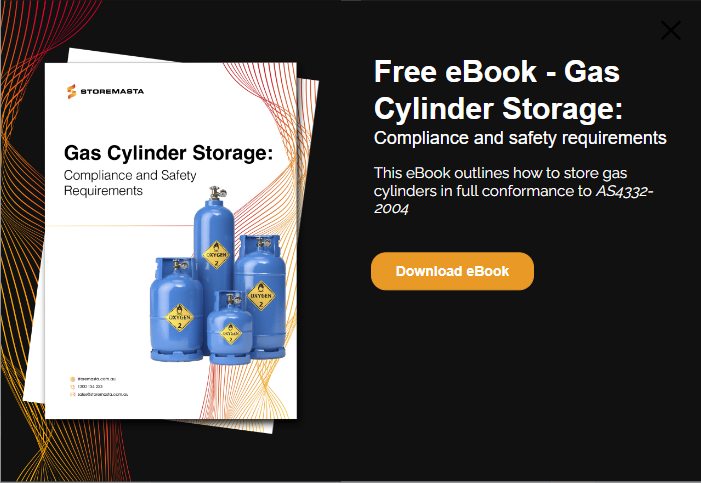This blog looks at Flammable Gases: what they are; the risks they present to people, property and the environment; and how to store them legally and safely. The management of Flammable Gases, like all Dangerous Goods is governed by a number of different Regulations and Standards; this blog focusing on storage essentials and identifies the key documents to review for more information.
Flammable Gases Defined
In Australia flammable gases are classified by the Australian Dangerous Goods Code (also known as the ADG Code). But the ADG Code itself is based on the Globally Harmonised System of Classification and Labeling of Chemicals (GHS) adopted and recommended by the United Nations. The definition of flammable gases according to the GHS is:
“Class 2.1 - Flammable Gas can be defined as gases at 20 °C and a standard temperature of 101.3 kPa are ignitable when in a mixture of 13% or less by volume in air.”
GHS (Section 3.1.2)
Examples of flammable gases regularly used in workplaces include: LPG, acetylene, hydrogen, propane, propylene and methane. These gases are also referred to as fuel gases and are easily ignited and potentially explosive.
Risks and Hazards of Flammable Gases
Flammable gases compressed in cylinders can cause fires and explosions in a number of different ways. These include:
1. Leaks
Even small gas leaks from cylinders under pressure can cause catastrophic events. Leaking compressed gases can quickly fill a room or confined space, with the accumulated gas remaining within its explosive range. Flammable gases that are denser than air are particularly dangerous because they can travel considerable distances to ignition sources.
Cylinders and valves should be inspected regularly for leaks, and damaged cylinders never be accepted from suppliers.
2. Damage to cylinders
Dropped or impacted cylinders can cause gases to rapidly disperse from the cylinder or rupture and explode.
Cylinders should always be treated with care to prevent impact damage. They must never be rolled along the ground or dropped/thrown during loading operations.
3. Exposure to dangerous events
When flammable gases in cylinders are exposed to dangerous events (like a fire that started in another part of the worksite) they may rupture violently from pressure build-up. Subsequent explosions can lead to fatalities, as well as catastrophic environmental and property damage.
Gas cylinders must be stored correctly along with a written fire/explosion emergency plan. Staff need to attend regular drills and incident response training.
4. Work practices and storage
Flammable gases stored or handled in areas exposed to ignition sources can ignite or explode. Ignition sources include:
- Naked Flames: cigarette lighters, matches, bunsen burners, spirit lamps, candles, pilot light
- Static Electricity: mobile phones, keyless remotes, thermostats, friction from clothing and fabrics, brush discharges.
- Hot work: welding, soldering, brazing, burning, heating, torch cutting
- Industrial Heat: radiators, boilers, steam pipes, furnaces, overheated machinery
- Sparks: grinders, industrial cutters, vehicle impact, machinery friction
- Electrical Equipment: overloaded extension cables, power-boards and circuits; exposed wiring; faulty equipment
- Natural sources: lightning, direct sunlight
Carry out thorough fire risk assessments identifying possible ignition sources and fire hazards. Then systematically introduce hazard control measures.
Storing Flammable Gases
Class 2.1 Flammable Gases must be stored according to the strict guidelines of the Australian Standard AS4332-2004 - The storage and handling of gases in cylinders. There are three key elements to storing Flammable Gases. These include:
1. Location
Flammable gases should be stored outdoors wherever possible. Outdoor storage reduces the dangers of gas leaks as the natural ventilation often dissipates leaked gas safely. The cylinder store should be level and at least 3 metres away from any plant, equipment or machinery that generates heat.
It’s also essential that the store is away from:
- Combustibles,
- Waste materials
- Vegetation/foliage
- Vehicles and traffic
- Building vents and openings
- Any possible ignition sources
2. Segregation and separation
According to the Australian Standard, Class 2.1 Flammable Gases must be segregated by at least 3 metres from Class 2.2 (5.1) Oxidising Gases and Class 2.3 Toxic Gases.
The segregation distance can also be achieved by using screen walls that are at least 1 metre higher than the tallest cylinder and impervious to the gases stored on either side.
3. Storage Methods
Cylinders containing flammable gases must be stored upright and restrained by chains or safety straps. It is also essential to ensure cylinder valves are closed, attachments like welding torches are removed, and safety caps in place.
The best way to store flammable gas cylinders is in a dedicated gas bottle cage that is secured with tamper-proof locks to prevent unauthorised access. The Standard clearly states that cylinders must be protected from any possible damage so if the cylinder store is exposed to passing traffic (eg. forklifts) your gas bottle cage should have bump rails and safety bollards.
Next Steps
To learn more about managing the risks and hazards when storing Class 2.1 Flammable Gases (as well as other compressed gases) download our free eBook Gas Cylinder Storage: Compliance and Safety Requirements. The eBook also contains the STOREMASTA methodology for risk management that can be used to control the hazards associated with the gas cylinders stored in your workplace. Download it now by clicking on the image below:
Joining the team as a Dangerous Goods Storage Consultant, Melissa Hampton became Storemasta's Marketing Manager in late 2021. With extensive knowledge and experience in chemical compliance, Melissa is responsible for leading the Marketing team and helping shape their marketing strategy. In her spare time, you can find Melissa hiking, swimming and enjoying the great outdoors in beautiful north-west Tasmania.